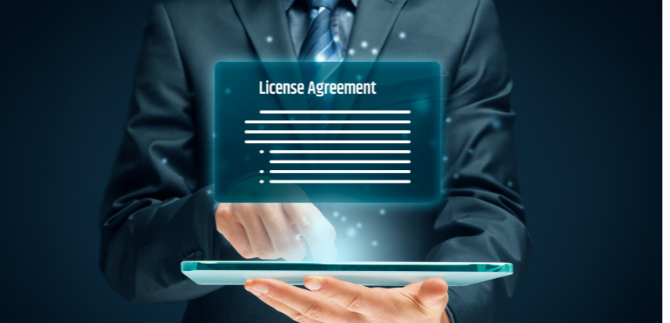You will need a software license agreement when you (being a licensor) want your proprietary software to be licensed to your customer (legally referred to as a licensee) for his/her use in return of a consideration. Under the existing regime of intellectual property (“IP”) laws in India, a licensor has certain exclusive rights over its creation which may be in the form of copyrights, patents, trademark or trade secrets.
When you license your software via a licensing agreement, you only give limited rights which are expressly authorized by you and do not transfer any ownership or title to the licensee. It leaves ownership with you and merely gives right to use and access the software to the licensee. Simply put, it works similar to a rental agreement. The vendor/landlord still holds the ownership of the house, but the customer/tenant gets to use it as per the terms and conditions laid down in the rental agreement.
A software license may be exclusive or non-exclusive, with or without a right to sublicense and transfer, may be limited to a specific geographic territory, with or without a right to make and store copies, and with a limited scope of access and use. All the above items may be decided by the parties on mutual discussion.
It is pertinent to note that the software needs to be downloaded or installed on the licensee’s platform/network/computer to be qualified under the ambit of software licensing and to be treated differently from SaaS and similar products.
This post will give you an overview of some essential clauses in a Software License Agreement.
1. Definitions: It is always important to clearly define the “Software” or “Licensed Product” usually in a separate definition clause. In a standard license, it’s usually enough to give the software’s name: “Software’ refers to Licensor’s [insert name of the product] software application”. If the customer needs to reproduce user manuals and other documentation, the definition might also include the same in the following manner: “The Licensed Product includes Licensor’s standard user manuals and other documentation for such software”. It is advisable to also define the term “Intellectual Property” to cover all the IP rights associated with the software.
2. License Grant: This clause will specifically lay out what kind of license you are offering to your customers, and ensuring that your customer is using the software within the boundaries of such limitations. These limitations may include non-transferability, non-exclusivity, no further licensing, territorial boundaries, revocability and more depending on the nature of software involved and the purpose of such licensing. Below is the suggestive language for this clause-
“Subject to the terms and conditions hereof, the Licensor hereby grants to the Licensee and the Licensee agrees to accept, a non-exclusive, revocable, non-transferable, non-sub-licensable and limited license to use and access the Software in [India]. Subject to the terms of this Agreement, the Licensee may allow its employees, vendors, and other identified third parties (hereinafter referred to as “Authorized Users”) to use the Software and the Licensee shall be responsible for its Authorized Users’ compliance with this Agreement.”
3. Use Restrictions: This clause will lay out the restrictions on your customer’s use of the software such as restriction on reverse engineer or committing any illegal activity with its use. Below is the suggestive language for this clause-
“Licensee shall not modify, alter, decompile, duplicate, decrypt, reverse engineer, obscure the Software, in any manner, without the prior written approval of the Licensor.”
“Licensee shall not use the Software in any unlawful manner, including but not limited to violation of any person’s rights or in breach of Applicable Laws.”
4. Intellectual Property Ownership and Feedback: This clause specifies that you own the IP rights of the software and the customer gets only the license to use the software. It should ideally also specify that any improvement in the
based on the feedback given by the customer shall be the sole property of the licensor.
“The Licensee agrees and acknowledges that it has been given a limited right to access and use the Software, during the term of this Agreement and has not acquired any legal rights in the IP owned by the Licensor. The Licensee further agrees and acknowledges that any and all IP rights, title and interest over the Software including without limitation any derivative works made, as well as any updates or upgrades thereto or all hardware, software and other components required for such purpose or any IP embodied in and/or attached/connected/ related to the Software, shall remain sole and exclusive property of the Licensor, at all times. The Licensor shall have a royalty-free, worldwide, transferable, sub-licensable, irrevocable and perpetual license to incorporate into the Software, or otherwise use any suggestions, recommendations or other feedback it receives from the Licensee.”
5. User Agreements: This clause ensures that your customer enters into valid and binding licensing agreements with all end users of the software, if any, and binds them with the same level of covenants of software license agreement entered between you and the customer. Below is the suggestive language for this clause-
“The Licensor shall ensure that the Software users, if any, are bound by the same if not more levels of obligation and standard with respect to IP rights, Confidential Information and terms of use of the Software. The Licensor shall ensure that binding agreements are executed with such users with obligations that are in accordance with this Agreement.”
6. Licensee’s Responsibilities: Use this clause to lay out the responsibilities of your customer, including but not limited to ensuring that the customer is liable for all the direct and indirect actions undertaken by the customer or by its authorised users, while using the software. Also specify that the customer should comply with all terms and conditions of your product.
7. Support and Update: This clause will lay down what kind of technical support you are offering your customer, and how they can get updates to the software, with or without additional cost. If such support and updates are specific in nature, we recommend putting those specifics in an attachment. If not, then the language can be used broadly. Below is the suggestive language for this clause-
“The Licensor shall provide the Licensee with adequate support services, upgrades to the Software, enhancements or modifications to the Software, [with or without additional cost].”
8. Confidential Information: The confidentiality clause is the topmost priority in the software license agreement. This clause will identify what is considered confidential, what are the do’s and dont’s while handling of such information. This clause will help you protect your confidential information.
“Confidential Information shall mean and include any information disclosed by the Licensor, either directly or indirectly, in writing, orally, electronic or other tangible form, including without limitation, any third party information, technical and business information, intellectual property rights, software programs, object codes, source codes, reports, performance data, materials, trade secrets, employee details, know-how, credentials, commercials, consideration, financial information and any other commercially valuable information and its proprietary information or any other information which is designated as “confidential”, “proprietary” or some similar designation in connection with the Software. The Licensee agrees that he/she/it shall not disclose the Confidential Information to any third party without the prior written approval of the Licensor. The Licensee shall use the same or greater degree of care in protecting the Confidential Information, as it uses for its own confidential information, but no less than reasonable care. The Licensee may share the Licensor’s Confidential Information only on a need to know basis, with its Authorized Users solely for the purpose of this Agreement and who are bound by similar if not stricter terms of confidentiality with the Licensee. The Licensee shall be solely responsible for the acts or omission of its representatives.”
Disclaimer: This article is for informational purposes only and shall not be construed as a substitute for legal advice.





